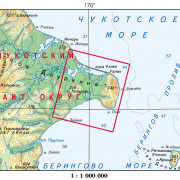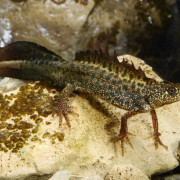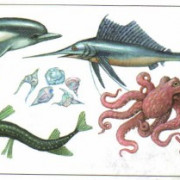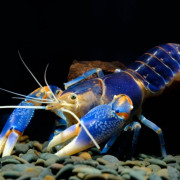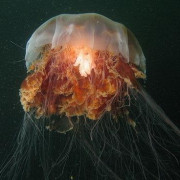Китовая акула самая большая в мире рыба
Содержание:
Внешний вид и особенности
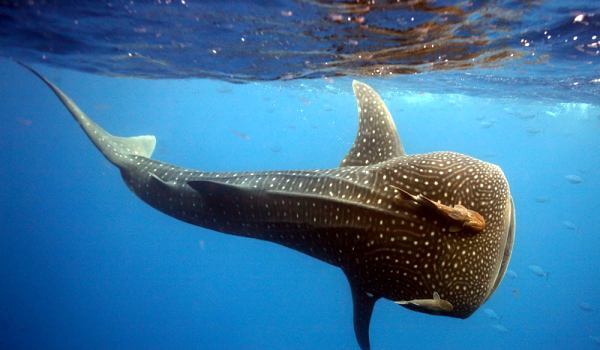
Фото: Яростная китовая акула
Китовую акулу трудно спутать с другими представителями животного царства. Причина в том, что, кроме колоссальных габаритов, она имеет и другие внешние особенности:
- Мощное тело, покрытое толстой кожей с крошечными остроконечными чешуйками. Кожа в области брюха несколько тоньше, поэтому в опасной ситуации рыба старается спрятать уязвимое место, поворачиваясь к врагу спиной.
- Сравнительно маленькая, несколько приплюснутая голова, которая переходит в плоскую морду с широкой (порядка полутора метров) пастью. Рот находится по центру рыла. Это еще одна специфическая черта, которая отличает эту акулу от других представителей семейства (у них рот расположен в нижней половине морды).
- За головой, с боков тела, имеется по пять щелей жабр. Они служат своеобразными ситами, пропускающими воду. Через жабры выходит и то, что рыба не может проглотить.
- Глаза небольшие, глубоко посаженные. Даже у больших особей диаметр глазного яблока не превышает 50 мм. Расположены они практически по краям от пасти. Мигательных перепонок у китовых акул нет. Однако, при опасности, глаза их втягиваются глубоко внутрь орбит и плотно закрываются кожной складкой.
- Максимальная ширина тела – непосредственно за головой. Оно постепенно сужается по направлению к хвосту.
- Китовые акулы имеют 2 спинных плавника, несколько смещенных назад. Первый немного больше и выше второго, в форме почти правильного треугольника. Хвостовой плавник у двенадцати метровых акул достигает 5 м, а грудные – 2,5 м.
- Зубы очень мелкие. Даже у самых крупных рыб они не превышают 0,6 см. Зато число зубов очень велико (порядка 15 тысяч). Отсюда и латинское наименование животного — Rhincodon, перевод которого означает «скрипящий зубами».
Долгое время считалось, что наибольшая длина представителей этого вида составляет около 12,7 м. Однако, согласно некоторым источникам, животные достигают и больших размеров. К концу прошлого столетия появилась официально зафиксированная информация об отдельных 20-метровых особях, вес которых достигает 34 т. Однако, подобные колоссы — редкость даже среди китовых акул. В среднем, длина их равна около 9,7 м, при массе порядка 9 т. Среди всех рыб планеты они — чемпионы по габаритам.
Окрас у рыб очень характерный. Спина и боковые поверхности тела темно-серые. Этот фон испещрен желтоватыми или грязно-белыми продольными и поперечными полосами. Между ними находятся отметины того же оттенка округлой формы. Голова и грудные плавники имеют такие же пятна, расположенные часто и хаотично. Брюхо светло-серого цвета. На коже плавников и тела имеются характерные бороздки-царапины, сливающиеся в единый рисунок. Характер «узора» для каждой особи уникален. С возрастом он не меняется, по виду рисунка можно распознать ту или иную рыбу.
Среда обитания и питание
Излюбленные места этих великанов — умеренно-теплые и тропические воды океанов и морей, поэтому чаще всего вид встречается в районах, где температура приповерхностного слоя воды находится на уровне от 21 до 26 °C. Ученые предполагают, что такая теплолюбивость связана не столько с физиологическими потребностями, сколько с пищевыми предпочтениями гиганта, поскольку в местах с наибольшей его популяцией, как правило, обнаруживаются и массовые скопления планктонных организмов — основной еды этой рыбы.
Районы, где обитают акулы китовые:
- Сейшелы и Тайвань — вблизи этих островов они присутствуют круглый год, хотя наибольшее сосредоточение наблюдается в летний и осенний периоды.
- Регионы, прилегающие к юго-восточному и восточному побережью Африканского континента. По подсчетам ученых, в прибрежных районах Мозамбика обитает пятая часть от общей численности вида.
- Небольшие популяции встречаются также в водах Австралии, Филиппин, Чили и Мексиканского залива.
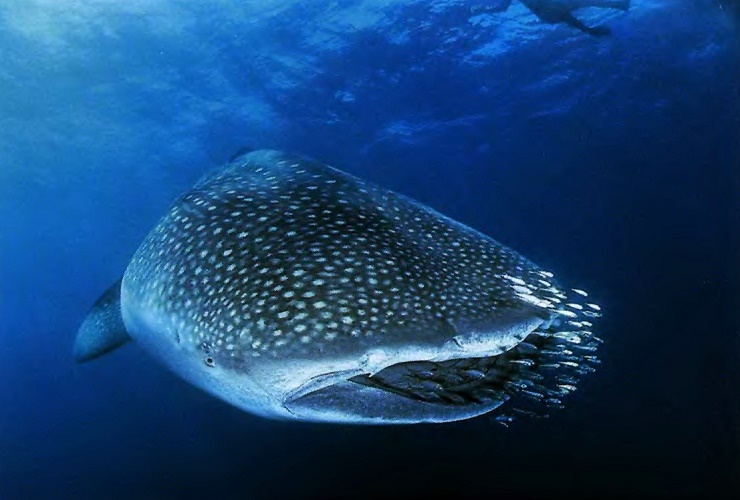
Китовая акула не кровожадна
Несмотря на свою принадлежность к семейству хищников и огромное количество зубов, эти рыбы вовсе не кровожадны, а их рацион в основном включает:
- зоопланктон;
- мелкие виды стайных рыб, а именно: анчоус, тунец, сардина и небольшие скумбриевые.
Как и усатые киты, акула медленно «пасется» в океане, отцеживая планктон. Для этого она очень широко раскрывает рот, набирая в него большое количество воды, после чего огромная пасть закрывается, а жидкость выходит через жабры, снабженные специальными фильтрами. В итоге во рту остаются лишь те водные обитатели, которые способны «протиснуться» в чрезвычайно узкий пищевод (диаметр всего около 10 см) гиганта. Таким образом, чтобы полностью насытиться китовая акула питается на протяжении целого дня (около 8−9 часов в сутки), при этом пропуская через свой рот и жаберные щели до 6 тыс. кубометров воды за час.
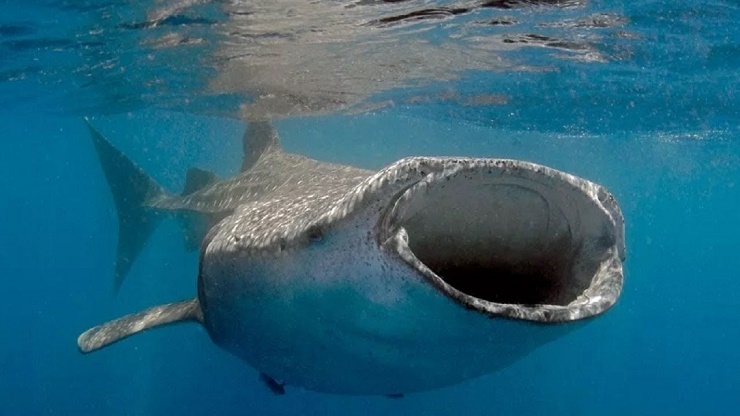
Китовая акула в основном питается планктоном
Популяция и статус вида
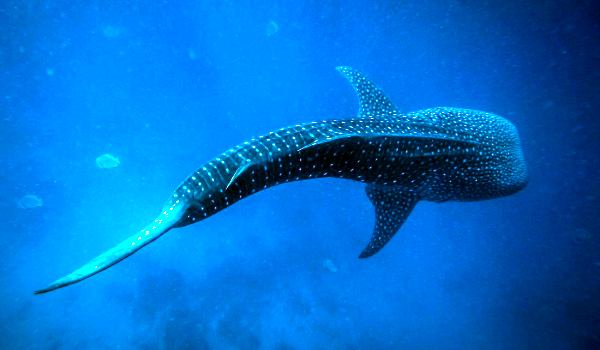
Фото: Как выглядит китовая акула
Численность китовых акул невелика. По некоторым сведениям, общее количество этих рыб на планете составляет около 1 тыс. особей. Основная причина резкого сокращения животных — бесконтрольный промысловый отлов их на Филиппинских островах и Тайване, где мясо, печень и плавники китовой акулы в большой цене. Истребляют этих рыб и из-за богатого полезными веществами акульего жира. Сокращению численности животных способствует и то, что промысловики стараются отлавливать самых крупных особей (а это, преимущественно, самки). Эти спокойные хищники — очень легкая добыча, поймать их достаточно просто. Иногда медлительное животное, почти не способное маневрировать, попадает под лопасти движущихся судов.
Согласно международному статусу, китовая акула относится к статусу вымирающих видов (с 2016 г., ранее он определялся как «уязвимый»). Вплоть до 2000 года статус животных значился как «неопределенный», поскольку информации о биовиде было недостаточно. Начиная с 90-х годов прошлого столетия, в ряде стран наложен запрет на вылов этих рыб.
Особенности характера и образа жизни
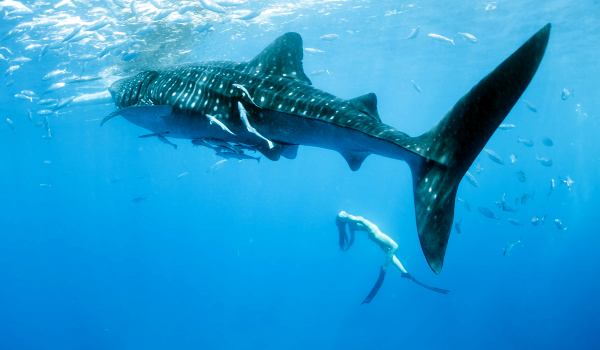
Фото: Самая большая акула
Большая часть ученых-ихтиологов склонная считать китовых акул спокойными, миролюбивыми и очень медлительными созданиями. Как правило, животное держится ближе к водной поверхности, но иногда уходит на 700-метровую глубину. Плавает рыба с небольшой скоростью – около 5 км/час, а иногда — и того меньше. Она активна практически круглые сутки, с небольшими перерывами на сон.
Эта разновидность акул совершенно безопасна для человека. Ныряльщики пользуются этим и не просто приближаются близко к рыбам, но и взбираются на них. Однако, раненые особи могут быть и опасны. Одного удара хвоста достаточно, чтобы убить человека или повредить небольшое судно.
Distribution and habitat
The whale shark inhabits all tropical and warm-temperate seas. The fish is primarily , living in the open sea but not in the greater depths of the ocean, although it is known to occasionally dive to depths of as much as 1,800 metres (5,900 ft). Seasonal feeding aggregations occur at several coastal sites such as the southern and eastern parts of South Africa; Island in the South Atlantic Ocean; in Djibouti, Gladden Spit in Belize; in Western Australia; ,, and coast of in India; in Honduras; ; , and in the Philippines; off and in and in , ; island, ; in Indonesia; in Nabire, Papua, Indonesia; ; in Madagascar; off Beach near in Mozambique; the Tanzanian islands of , , ; in , the in the and Al Hallaniyat islands in the ; and, very rarely, , Israel and , Jordan. Although typically seen offshore, it has been found closer to land, entering lagoons or coral atolls, and near the mouths of estuaries and rivers. Its range is generally restricted to about 30° latitude or lower. It is capable of diving to depths of at least 1,286 m (4,219 ft), and is migratory. On 7 February 2012, a large whale shark was found floating 150 kilometres (93 mi) off the coast of , Pakistan. The length of the specimen was said to be between 11 and 12 m (36 and 39 ft), with a weight of around 15,000 kg (33,000 lb).
In 2011, more than 400 whale sharks gathered off the Coast. It was one of the largest gatherings of whale sharks recorded. Aggregations in that area are among the most reliable seasonal gatherings known for whale sharks, with large numbers occurring in most years between May and September. Associated ecotourism has grown rapidly to unsustainable levels.
Description

Jaws
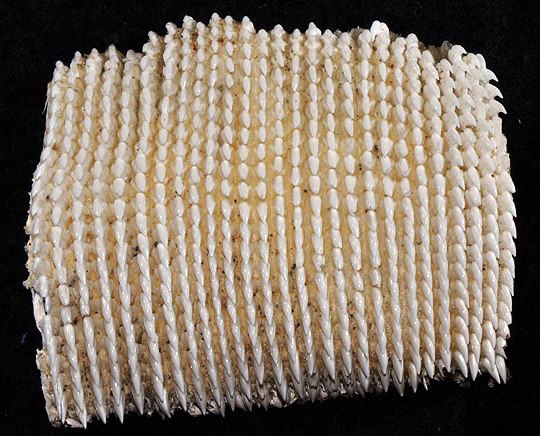
Teeth
The complete and annotated genome of the whale shark was published in 2017.
Size
The whale shark is the largest non- animal in the world. The average size of adult whale sharks is estimated at 9.8 m (32 ft) and 9 t (20,000 lb). likely occurs at over 9 m (30 ft) in length. Specimens near 18 m (59 ft) in length have been reported, however, whale sharks over 12 m (39 ft) are uncommon. The largest total length the species can reach is uncertain due to a lack of information on how measurements were taken in many of the reported individuals. Large whale sharks are difficult to accurately measure both on the land and in the water. When measured on land, the total length can be affected by how the tail is positioned, either being angled as it would be in life or stretched to the maximum possible. Historically, techniques such as comparisons to objects of known size and knotted ropes have been used for in-water measurements and may suffer from inaccuracy. In 2011 laser was proposed to improve measurement accuracy.
Reports of large individuals
In 1868, the Irish natural scientist obtained several small whale shark specimens in the Seychelles. Wright was informed of one whale shark that was actually measured as exceeding 45 ft (14 m). Wright claimed to have observed specimens in excess of 50 ft (15 m) and was told of specimens upwards of 70 ft (21 m).
In a 1925 publication, described a huge animal caught in a bamboo fish trap in Thailand in 1919. The shark was too heavy to pull ashore and no measurements were taken. Smith learned through independent sources that it was at least 10 (a Thai unit of length measuring between a persons outstretched arms). Smith noted that one wa could be interpreted as either 2 m (6.6 ft) or the approximate average of 1.7 m (5.6 ft) to 1.8 m (5.9 ft) m based on the local fishermen. Later sources have stated this whale shark as approximately 18 m (59 ft) and the accuracy of the estimate has been questioned.
In 1934, a ship named the Maunganui came across a whale shark in the southern Pacific Ocean, rammed it, and the shark became stuck on the prow of the ship, supposedly with 15 ft (4.6 m) on one side and 40 ft (12.2 m) on the other, suggesting a total length of about 55 ft (17 m).
A large specimen was caught on 11 November 1949, near , in , Pakistan. It was 12.65 m (41.5 ft) long, weighed about 21.5 t (47,000 lb), and had a girth of 7 m (23 ft).. In 1983 a whale shark was caught in a net off the coast of and detailed measurements were taken from all over the body; it was found to have a total length of 12.18 m (40.0 ft) with an approximate estimated weight of 11,018 kg (24,291 lb). This was considered the largest accurately measured specimen by J. G. Coleman in 1997.
A shark caught in 1994 off , southern Taiwan, reportedly weighed 35.8 t (79,000 lb). Using length to weight equations calculated from whale sharks, Hua Hsun Hsu and colleagues estimated two individuals reported as weighing 34 t (75,000 lb) and 42 t (93,000 lb) at 16 m (52 ft) and 17.3 m (57 ft) in length respectively.
Scott A. Eckert & Brent S. Stewart reported on of whale sharks from between 1994 and 1996. Out of the 15 individuals tracked, two females were reported as measuring 15 m (49 ft) and 18 m (59 ft) respectively. A whale shark was reported as being stranded in 1995, along the coast, measuring 20.75 m (68.1 ft) long. A female individual with a of 15 m (49 ft) (and an estimated total length at 18.8 m (62 ft)) was reported from the Arabian Sea in 2001. In a 2015 study looking into the size of marine , McClain and colleagues considered this female as being the most reliable and accurately measured.
Reproduction
Pupping of whale sharks has not been observed, but mating has been witnessed twice in . Mating in this species was filmed for the first time in whale sharks off via airplane in Australia in 2019, when a larger male unsuccessfully attempted to mate with a smaller, immature female.
The capture of a female in July 1996 that was pregnant with 300 pups indicated that whale sharks are . The eggs remain in the body and the females give birth to live young which are 40 to 60 cm (16 to 24 in) long. Evidence indicates the pups are not all born at once, but rather the female retains sperm from one mating and produces a steady stream of pups over a prolonged period. They reach sexual maturity at around 30 years and their lifespan is an estimated 70 to 100 years.
On 7 March 2009, marine scientists in the Philippines discovered what is believed to be the smallest living specimen of the whale shark. The young shark, measuring only 38 cm (15 in), was found with its tail tied to a stake at a beach in , Philippines, and was released into the wild. Based on this discovery, some scientists no longer believe this area is just a feeding ground; this site may be a birthing ground, as well. Both young whale sharks and pregnant females have been seen in the waters of St Helena in the South Atlantic Ocean, where numerous whale sharks can be spotted during the summer.
References
- ^
- Smith, Andrew (5 November 1828). . . 3 (145) – via Document Delivery System. Reprinted in .
- ^
- ^
- ^
- ^
- ^
- ^
- . Home Page of Henry F. Mollet, Research Affiliate, Moss Landing Marine Laboratories.
- ^ Jurassic Shark (2000) documentary by Jacinth O’Donnell; broadcast on , 5 August 2006
- ^
- ^
- ^
- ^ Matsumoto; Toda; Matsumoto; Ueda; Nakazato; Sato; Uchida (2017). «Notes on Husbandry of Whale Sharks, Rhincodon typus, in Aquaria». In Smith, Mark; Warmolts; Thoney; Hueter; Murray; Ezcurra (eds.). The Elasmobranch Husbandry Manual II. Ohio Biological Survey. pp. 15–22. 9780867271676. .
- ^
- ^
- ^ Schreiber, C; Coco, C (2017). «Husbandry of Whale Sharks». In Smith, Mark; Warmolts; Thoney; Hueter; Murray; Ezcurra (eds.). The Elasmobranch Husbandry Manual II. Ohio Biological Survey. pp. 87–98. 9780867271676. .
- Bennett; Kaiser; Selvan; Hueter; Tyminski; Lötter (2017). «Rescue, Rehabilitation and Release of a Whale Shark, Rhincodon typus, in the Arabian Gulf». In Smith, Mark; Warmolts; Thoney; Hueter; Murray; Ezcurra (eds.). The Elasmobranch Husbandry Manual II. Ohio Biological Survey. pp. 229–235. 9780867271676. .
- ^
Diet

Whale shark in Maldives

A whale shark in the Philippines with
The whale shark is a – one of only three known filter-feeding shark species (along with the and the ). It feeds on including , , , larvae and small life, such as small or . It also feeds on clouds of eggs during mass spawning of fish and corals. The many rows of vestigial teeth play no role in feeding. Feeding occurs either by ram filtration, in which the animal opens its mouth and swims forward, pushing water and food into the mouth, or by active suction feeding, in which the animal opens and closes its mouth, sucking in volumes of water that are then expelled through the gills. In both cases, the filter pads serve to separate food from water. These unique, black sieve-like structures are presumed to be modified gill rakers. Food separation in whale sharks is by , in which the water travels nearly parallel to the filter pad surface, not perpendicularly through it, before passing to the outside, while denser food particles continue to the back of the throat. This is an extremely efficient filtration method that minimizes fouling of the filter pad surface. Whale sharks have been observed «coughing», presumably to clear a build-up of particles from the filter pads. Whale sharks migrate to feed and possibly to breed.
The whale shark is an active feeder, targeting concentrations of plankton or fish. It is able to ram filter feed or can gulp in a stationary position. This is in contrast to the passive feeding basking shark, which does not pump water. Instead, it swims to force water across its gills.
A juvenile whale shark is estimated to eat 21 kg (46 pounds) of plankton per day.
The BBC program filmed a whale shark feeding on a school of small fish. The same documentary showed footage of a whale shark timing its arrival to coincide with the mass spawning of fish shoals and feeding on the resultant clouds of eggs and sperm.
Whale sharks are known to prey on a range of planktonic and small nektonic organisms that are spatiotemporally patchy. These include krill, crab larvae, jellyfish, sardines, anchovies, mackerels, small tunas, and squid. In ram filter feeding, the fish swims forward at constant speed with its mouth fully open, straining prey particles from the water by forward propulsion. This is also called ‘passive feeding’, which usually occurs when prey is present at low density.


